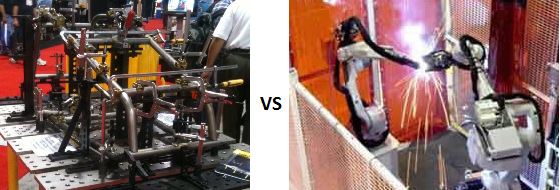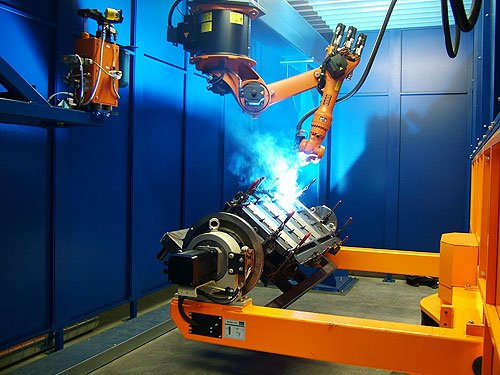The Evolution and Advantages of Jig-less Robotic Welding

Posted on May 18, 2011 in Robotic Welding
3 min read time

Are you having trouble finding welders? Are you wondering how you could take advantage of robots to simplify your fixtures and reduce their costs? It might be worth looking at a jig-less robotic welding approach.
In most robotic welding applications, a jig is used to hold work pieces together before they are welded. The jig can be loaded and unloaded by a human operator or by robots. Loading the jig can be time consuming and does not add value to the process. Jigs are often custom made so they remove a lot of flexibility in the overall process. Anytime a manufactured product evolves, the jig is typically modified manually. In jig-less welding, a robot will hold parts together while they are welded by a robot arc welder. Here's a simplified review of the evolution of welding improvement methods and their advantages.
Conventional Robot Welding
A human mounts work pieces in the jig and a robot welds the pieces together. The main improvement here is made over faster welding cycle time with less labor cost, more precision and consistency in welding with less wasted materials. Example:
First improvement: Robot loads and unloads the jig
In this method, robots are used in loading parts inside the jig. In this case, the jig and the revolving table are still used. This improvement step can potentially increase the arc-on time, reduce cycle time and removes human workers from being in contact with dangerous welding environments. Example:
Second improvement: Jig-less robotic welding
Robots hold parts together while one, or more, robots weld simultaniously. This method offers the best welding path flexibility by giving access to hard-to-reach parts. It is also the most cost-effective when a high variety of parts are involved since extra jig setups are eliminated. This also provides the fastest welding cycle time.
The jig-less welding method offers the all the advantages of robotic welding and more:
- Faster welding cycle time
- Increase in production with minimal / no breaks
- Less wasted material
- Consistent weld seams
- Increase in safety for human workers
- Greater precision in welding
- Flexibility in manipulating and handling a high variety of different work-pieces with less cost
Return On Investment (ROI) can be reached quickly, especially when facing high numbers of production changes (saving on the jig setup cost each time). Example:





Leave a comment